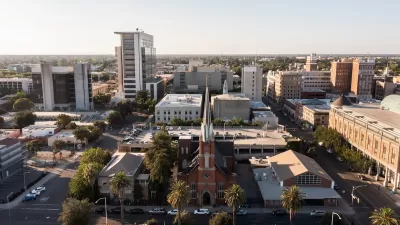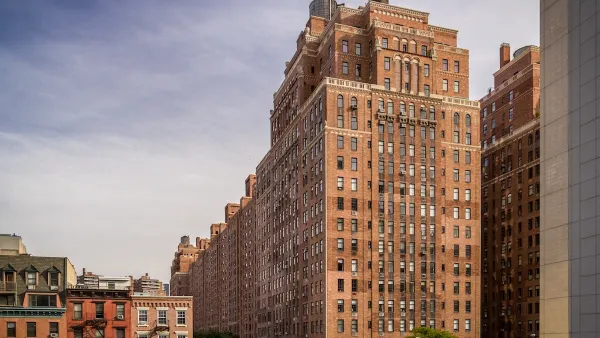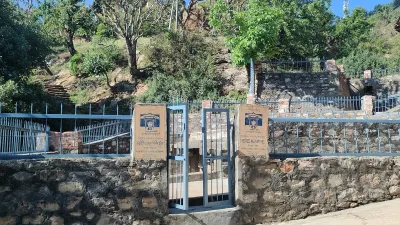A group of Cambodian immigrants took partial control of an affordable housing property in the 90s, and since then, they’ve made big changes to the complex. But they haven’t been able to get full legal control of the property for decades. Why?

This article is republished from Shelterforce Magazine.
In the mid-1980s, Park Village Apartments could charitably have been viewed as needing some attention. The low-income apartment complex in Stockton, California, was in disrepair, with leaking roofs, sewage issues, abandoned cars, and stretches of dirt where landscaping should have been. Children living there had no place to play.
Almost 40 years later, the development is an entirely different place. Roofs and plumbing issues have been addressed, well-maintained gardens brighten the property, and the complex boasts a community center, a multi-purpose room with a commercial kitchen, and a playground.
The improvements were made over time by the complex’s residents, Cambodian immigrants who in 1993 took control of the property from the U.S. Department of Housing and Urban Development.
But even as the tenants were making decisions, allocating millions of dollars for renovations, and spending afternoons and weekends cleaning and beautifying the complex, the group didn’t have total legal control of the property. Even today, 31 years after the contract of sale was signed, HUD has still not formally approved the residents’ full ownership of the apartment complex.
Seeking safety and security
In the early 1980s, Stockton welcomed a large number of immigrants fleeing Cambodia’s murderous Khmer Rouge regime. Some came to live at Park Village Apartments, a 230-unit, privately owned affordable housing complex near downtown. Few spoke English.
Even then, the development was rundown. “It was in very bad condition,” says Sovanna Koeurt, who immigrated from Cambodia in 1984 with her husband and two small children. “They never fixed anything. It was almost uninhabitable.” The units were largely uninsulated and cold, some bore signs of having been flooded, and many were infested with cockroaches.
With more than 250 big Cambodian families squeezed into small apartments, Park Village became increasingly dismal. Gambling was common, and families under stress were showing signs of domestic violence. Teens looking to gain acceptance joined gangs, and drive-by shootings began to occur. A local journalist later described it as a “squalid, overcrowded Cambodian ghetto.”
In 1989, unrelated to the complex’s gang issues, a man with reported anti-Asian sentiments shot five children at a Stockton school. Four of them lived at Park Village, and another 18 children from the complex were injured. It was one of the nation’s first school shootings.
That incident was the impetus for the creation of a new group. Koeurt and 35 other Cambodian families came together to establish the Asian Pacific Self-Development and Residential Association, or APSARA. (In Cambodian culture an Apsara is a divine spirit, as well as a dance form.) One of the organization’s original goals was to find or build a new home for themselves—somewhere where they and their families could be safe and heal from the traumas they’d experienced.
During the same time, many owners of low-income housing developments across the U.S. had loans in default. The energy crisis hit landlords hard, with operating costs for their properties trending higher than the rent they could collect. Other developments had simply been poorly constructed, and the cost of repairs eventually became untenable. Because the federal government had insured these developments, ownership defaulted to HUD once the loans were paid.
Park Village wasn’t spared. Around the time of APSARA’s formation, the complex’s owner defaulted on the property and HUD took ownership.
Another trend in affordable housing was underway then, too. Jack Kemp, then-secretary of HUD under President George H.W. Bush, was a disciple of homeownership as an antipoverty tool, and he pushed for resident ownership of properties under new programs like HOPE I and HOPE II.
HUD properties sold to tenant groups
“There was real interest in advantaging more resident control and resident ownership of HUD assets,” says Jim Grow, senior staff attorney at the National Housing Law Project and an expert on the preservation of privately owned, federally subsidized housing developments.
APSARA began talking to HUD about acquiring Park Village for its own use. In 1991, HUD agreed and conducted a nonjudicial foreclosure of the property. In October 1993, the agency disposed of the property to Park Village’s residents for $1.
An article in The Sacramento Bee quoted William Bolton, a Sacramento-based HUD official who oversaw hundreds of affordable multifamily complexes in the northern half of California, saying, “This is the ultimate in tenant empowerment.” Other HUD leaders were similarly enthusiastic about the deal.
The agency agreed to continue to subsidize residents’ rents, and—as continues to be the case today—families paid no more than 30 percent of their monthly income.
Beginning from the ground up
Technically, HUD sold the development not to APSARA but to a new nonprofit called Park Village Apartments Inc. According to HUD’s disposition agreement, for the next five years, half of the nonprofit’s board of directors would be represented by APSARA; the other half would come from a local nonprofit, the Rural California Housing Corporation (RCHC), which would assist APSARA in developing the skills and capacity needed to successfully govern the complex. The memorandum of understanding stated that “at the end of [a] five-year period, APSARA and RCHC agree that RCHC’s role with the corporation shall end.”
In 1994, renovations began at Park Village Apartments. A community center was also remodeled, and a park was added for children. Photo courtesy of Jay Cumberland
Full control of Park Village Apartments Inc. by APSARA was also conditioned on solving the complex’s overcrowding issues.
Requiring new tenant owners to initially partner with an existing local nonprofit was a common requirement by HUD in instances like this one.
“It was so that HUD would have some assurance that the ownership entity was capable of doing the job,” says Grow. “There are a lot of examples where these things have gone into the tank.”
Technically, however, it meant that RCHC co-owned the apartment complex for as long as its representatives served on the board.
That fact may not have been entirely clear to APSARA’s leaders, due to language and cultural barriers. “Meetings and documents were never professionally translated into Khmer for APSARA,” says Jay Cumberland, a lawyer with the Oakland-based Sustainable Economies Law Center who has been helping the group. Koeurt provided basic translations for her fellow residents, but Cumberland suspects that much of the legal minutiae wasn’t conveyed.
Additionally, Koeurt has said that written contracts were not prominent in Cambodia, so she and other residents didn’t realize their significance in this situation. As a result, residents may not have fully grasped that they didn’t completely control the property.
And they were busy and distracted trying to improve the development. Koeurt, who has led APSARA for its full 35-year history, says that managing a property like Park Village was remarkably challenging. “For five years, we had a lot of issues to take care of,” she says.
Fixing the buildings, that’s easy . . . But fixing the social behaviors—not easy.”
Sovanna Koeurt, APSARA founder
With RCHC’s help, Park Village Apartments Inc. received a $7 million loan from Bank of America for renovations. Appliances, cabinets, floors, and other interior elements were replaced, as were roofs, balconies, and sidewalks. Twenty-two new four-bedroom apartments were created to reduce overcrowding. And the group built a community hall for classes and activities, and created gardens where residents planted lemongrass, onions, flowers, and Cambodian vegetables.
RCHC helped train APSARA’s members to address the complex’s physical issues. But there remained much more to do. “Fixing the buildings, that’s easy,” says Koeurt. “But fixing the social behaviors—not easy.”
FULL STORY: Will This Resident Group Get Full Control of the Complex They Helped Fix?

Planetizen Federal Action Tracker
A weekly monitor of how Trump’s orders and actions are impacting planners and planning in America.

Restaurant Patios Were a Pandemic Win — Why Were They so Hard to Keep?
Social distancing requirements and changes in travel patterns prompted cities to pilot new uses for street and sidewalk space. Then it got complicated.

Map: Where Senate Republicans Want to Sell Your Public Lands
For public land advocates, the Senate Republicans’ proposal to sell millions of acres of public land in the West is “the biggest fight of their careers.”

Maui's Vacation Rental Debate Turns Ugly
Verbal attacks, misinformation campaigns and fistfights plague a high-stakes debate to convert thousands of vacation rentals into long-term housing.

San Francisco Suspends Traffic Calming Amidst Record Deaths
Citing “a challenging fiscal landscape,” the city will cease the program on the heels of 42 traffic deaths, including 24 pedestrians.

California Homeless Arrests, Citations Spike After Ruling
An investigation reveals that anti-homeless actions increased up to 500% after Grants Pass v. Johnson — even in cities claiming no policy change.
Urban Design for Planners 1: Software Tools
This six-course series explores essential urban design concepts using open source software and equips planners with the tools they need to participate fully in the urban design process.
Planning for Universal Design
Learn the tools for implementing Universal Design in planning regulations.
Heyer Gruel & Associates PA
JM Goldson LLC
Custer County Colorado
City of Camden Redevelopment Agency
City of Astoria
Transportation Research & Education Center (TREC) at Portland State University
Camden Redevelopment Agency
City of Claremont
Municipality of Princeton (NJ)





























